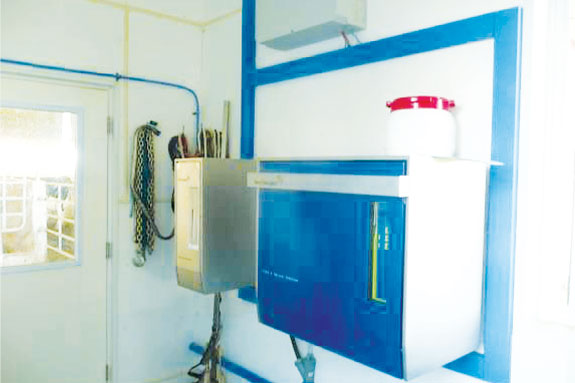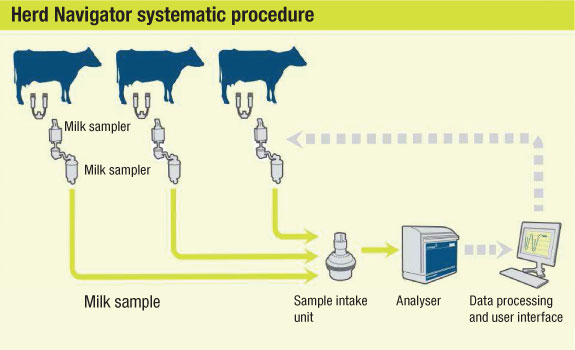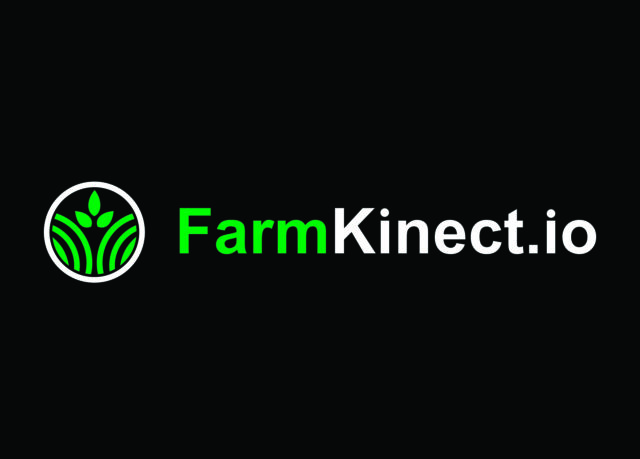
As herd sizes grow larger, it becomes increasingly more difficult to keep tabs on what is happening with each and every cow. But even a herd of one would struggle to know what is happening inside that cow.
A new technology being released this month at Canada’s Outdoor Farm Show in Woodstock, Ontario, helps provide that internal look by using milk samples to give insight to reproduction, udder health and feeding and energy balance ... thus allowing a farmer to “manage by exception,” says Muhieddine Labban, AMS solution manager, DeLaval Inc., Canada.
 Labban continues, “Instead of the farmer having to go through all his herd every day or several times a week – if a farmer had 65 cows or 100 cows or 200 cows, imagine the time consumed on checking each and every cow in relation to the three major functions Herd Navigator delivers.
Labban continues, “Instead of the farmer having to go through all his herd every day or several times a week – if a farmer had 65 cows or 100 cows or 200 cows, imagine the time consumed on checking each and every cow in relation to the three major functions Herd Navigator delivers.
As opposed to 10 to 30 minutes in the morning to just see the cows selected by the system.”
Herd Navigator, sold by DeLaval, is the result of a collaborative research and development effort started in 2001.
Danish development company Lattec I/S built an automated sampling and measurement system for in-line milk testing.

It was combined with software developed by Biosens that includes biometric and biological models.
According to DeLaval nutrition and herd management specialist Dr. Nancy Charlton, DVM, Dr. Jens Yde Blom of Biosens wanted to develop a management tool with a “brain” in it.
All other tools until this point required the farmer to be the biomodel, to take in the information and decide the proper course of action.
“One of the main purposes of such tools is to make a farmer’s life easier,” Labban says, “to save him time and allow him to use that time for other routines within his dairy farm.”
One analyzer can be installed on up to four DeLaval VMS (voluntary milking systems or robotic milking) units or in most DeLaval ALPRO™ milking parlours.
Sample collecting units are placed in each VMS unit or on each of the milk meters in the parlour. Milk is collected at intervals based on stage of lactation and previous sample results, determined by parameter settings and followed by the biomodel input.
Samples are moved to the sample intake unit, which organizes the sampling. Once collected, milk samples are sent to an analyzer, which serves as an on-farm laboratory.
It does the analysis and sends the data to a software interface on the farm’s computer. Results are generated into user-friendly tables and charts.
Milk samples are tested for ketosis by measuring beta hydroxybutyrate (BHB), mastitis through lactate dehydrogenase (LDH), urea levels through milk urea nitrogen and reproduction status though progesterone.
The system’s heat detection ability was the main reason Chris Buchner of Elmwood Farm in Oxford County, Ontario, wanted to give it a try.
His and three other dairy operations have served as reference farms for DeLaval, testing this new technology for the past year. (Click here to read about how Heegstege Farms, another reference farm, has changed how it now works with its veterinarian.)
Buchner, who milks 180 cows in a family operation consisting of two brothers and four offspring, was looking for a method of heat detection to employ on his farm when he first heard about this idea.
He learned more about it at the 2010 Precision Dairy Conference in Toronto. When it came time to test the technology in Canada, DeLaval contacted him and he took it on as a joint venture with his dealer, Norwell Dairy Systems Ltd.
The system was up and running in Buchner’s double-eight parallel parlour in November 2011 and “it’s still pretty new to us,” he says.
The main driver behind this system is progesterone monitoring. It is set up to begin testing for progesterone levels 20 days before the end of a cow’s voluntary waiting period, the length of which is determined by the farm.
That establishes the progesterone curves, so when the waiting period is up a producer can start breeding.
“There’s no more need for a blanket drug use program,” Charlton says, which she acknowledges has and can work well. Yet this system will help those producers that prefer to breed on natural heats.
“You can see what the cow is doing in a two-month time period from day 40 in milk to day 100. We see her every cycle. It may be 24 days instead of 21 days. She may go cystic; she may be anestrous when she starts – but we see those curves and we see exactly what is happening,” Charlton says.
“Farmers now have a tool they can be selective with,” she continues. “Once a cow hits 60 days and has a good progesterone curve, they can breed her or work with their vet to create an SOP that is cost-effective for the farmer.”
She has found that some cows may just need a little more time to start cycling and don’t need to be put on hormones right away. With this technology, a farm can wait and see and the system won’t miss her on the next heat.
As noted, Buchner is using the system mostly for the progesterone test to aid in heat detection and to pinpoint her optimal breeding time, which is 24 to 48 hours from when a cow is detected by the system.
Since beginning its use, the farm has moved conception rates from 28 to 30 percent up to 33 percent. They also quit using Ovsynch on most of the herd to now using it just on cystic cows. “It helps our vet identify anestrous cows and both follicular and luteal cysts. It gives us an idea of what’s going on inside the cow,” Buchner says.
Once a cow is declared pregnant, first noticed by a sustained level of high progesterone, the system no longer tests her for progesterone during that lactation.
Buchner says he is also using the ketone test quite a bit. “This was a good summer to put it to the test, given the heat and humidity,” he reports. “Cows that freshened were slow to get on feed.”
With the help of this system, he can watch for subclinical ketosis and is able to treat those cows early to avoid long-term problems.
Ketosis can now be detected days, if not weeks, earlier than before, Charlton says. Milk samples are measured for BHB starting at day four postpartum and continuing daily for 17 days. Then the biomodel begins and tests as needed until day 60.
“The farmer can watch the cow and see when she’s thinking of becoming ketotic,” Charlton says.
She explains the industry currently defines a state of ketosis as BHB levels at or greater than 1.4 mMol per litre. This system will show a producer when levels go from 0.8 to 1.0 to 1.1 and producers are able to act when they first see the number climbing. Working with their veterinarian and nutritionist, they can set the system to notify them at any chosen point.
“These notifications are occurring days, if not weeks before a farmer who uses other tools such as milk production or going totally off feed,” Charlton says.
The farmer is able to intervene extremely early and use a protocol suggested by his herd veterinarian. His nutritionist is also able to see what is happening and evaluate transition and fresh cow rations and environments to make any necessary changes.
Testing for mastitis occurs often in the early part of lactation and becomes more widespread as the cow’s lactation continues. Easing up on the testing occurrence did not sit well with Buchner at first, but he’s changed his mind the more he’s worked with it.
“I can now see why it is set up that way,” he says. “It is more accurate than I thought it was.”
When the system first detects mastitis in a cow, Buchner says he didn’t notice any reason as to why – she didn’t drop in milk production or show any physical signs like swelling or clotting.
However, by the third time the machine showed elevated levels of LDH in a cow, she was in a clinical state.
“You have to learn to trust what you are seeing (on the computer),” he says.
“For mastitis, this is a huge paradigm shift that the farmer has to be prepared to enter into,” Charlton says. Rather than what was once known as the “See clots. Treat.” method to managing mastitis, the disease can now be detected when a cow’s body first begins fighting the infection.
“LDH increases at the very early stage of infection,” she says. “This allows dairy producers time to work through an SOP to culture the bacteria in a petri dish and treat the cow early with the right tool to knock out the infection.
“This is the first tool I’ve seen that we can treat the right cow, with the right drug at the right time or the right cow is not treated,” Charlton adds.
The urea test is fairly straightforward, she says. When urea goes up, it allows a producer to evaluate their protein sources and how they are balanced with energy in the rumen.
“With the price of protein on the futures, the last thing we want to do is overfeed,” Charlton says, “and of course we don’t want to reduce our inputs such that we underfeed.”
The system’s software programs allow for the producer and veterinarian to write in their own SOPs. Therefore, when test results come in, the software generates action lists for the producer to follow based on what is best for their farm.
Buchner says one downside to the system is that a lot of the software is currently designed for the European style of management, as that is where it originated. He suggests some changes be made to the software to better reflect the North American style.
As an early adopter of this technology, he says he looks forward to future adaptations to the system. As he understands it, the testing carousels have additional openings and more tests can be incorporated easily in the future. “Once you have the milk sample, you can run as many tests as necessary,” Buchner says.
“I am of the opinion that cowside testing is where the finer points of management will come from in the future,” he adds.
Although he does admit it has been an adjustment. Nearing the age of 60, he has spent the better part of his life managing a dairy herd through physical observation and trusting his instincts.
He now has to trust data generated from a computer before those physical signs are apparent, yet he concedes, “This has greatly improved my ability to manage.”
Anyone interested in this technology should consult with his or her DeLaval dealer. Parlour operations will need to be inspected to rule out any design issue that may prevent the installation of the system.
The dealer can also help figure out the investment specific to each farm. According to Labban, the investment value of the system ranges from $80,000 to $120,000, depending on the size of parlour or number of VMS units, as well as the number of consumables required.
Buchner says he hasn’t been using the system long enough to comment on all of the savings he hopes to achieve, but he is already seeing small gains.
He has reduced the use of Ovsynch on the entire herd and only uses it as needed for hard-to-breed cows. Conception rates have increased and pregnancy rates are up slightly. He also finds they are using less semen.
He estimates there will be more cows in calf, resulting in more cows to sell, fewer mastitis implications from earlier detection and a reduction in veterinary visits – as he says he might reduce herd checks from once a week to once every two weeks.
According to Charlton the use of this technology is very beneficial. “All in all, we’re treating the right cows with the right protocol/the right drugs at the right time.
To me that just spells dollar savings, responsible use of pharmaceuticals, increased cow longevity, improved genetics and the list goes on. In short, it is a new focal point for sustainable farming,” she says. PD
PHOTO
As a part of the Herd Navigator system, the sample intake unit (left) sorts the milk samples collected during milking, while the analyzer (right) performs laboratory testing directly on a dairy farm. Photo courtesy of DeLaval.
YOUR RESULTS
Would you benefit from this type of management tool?
The following checklist can be used to determine if this new technology might be a fit for your operation.
1. Do you own a DeLaval VMS milking unit or ALPRO™ parlour?
2. Would you like help with heat detection?
3. Are you interested in breeding primarily from natural heats?
4. Do you want to increase conception rates on your farm?
5. Would you like to detect health problems earlier in your herd?
6. Are you interested in finding cows that have subclinical mastitis?
7. Do you want help in detecting cows with subclinical ketosis?
8. Would regular milk urea nitrogen tests be useful to you?
9. Would you like to reduce the amount of pharmaceuticals used?
If you answered yes to seven or more of these questions, this technology may be one for you to consider.









